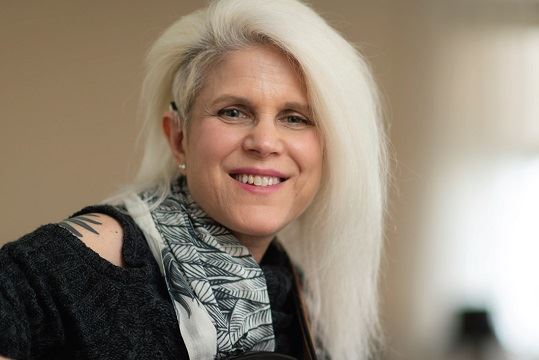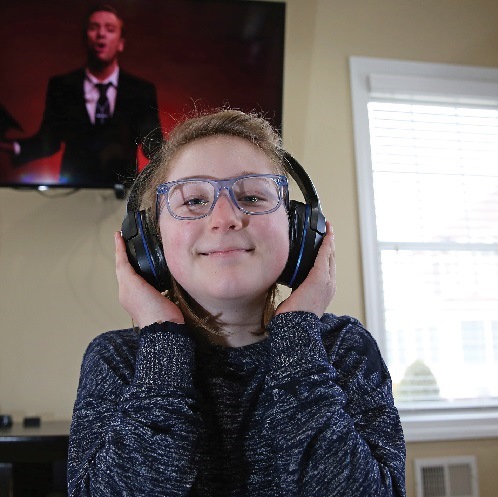"I'm happy to have my life back"

Two New Devices Are Transforming the Lives of People Who Struggle with Single-Sided Deafness
Many Americans have moderate-to-severe hearing loss in one ear that makes it difficult, if not impossible, for them to go about their day-to-day activities. For years, the only treatments available were hearing aids and bone-conduction devices, but they aren’t ideal for people with single-sided deafness, says P. Ashley Wackym, MD, a hearing and balance surgeon at Robert Wood Johnson University Hospital (RWJUH), Professor and Inaugural Chair of Rutgers Robert Wood Johnson Medical School’s Department of Otolaryngology-Head and Neck Surgery, and Chancellor Scholar at Rutgers Biomedical and Health Sciences.
Hearing aid systems called contralateral routing of signal (CROS) simply reroute sound from the bad ear to the good ear, so it’s difficult for a patient to determine where sound is coming from. Older, surgically implanted bone conduction devices, such as the Baha, involve attaching an external hearing aid to a metal implant that passes through the skin to carry sound through the skull to the opposite ear. With these systems, skin irritation and even infections are not uncommon.
Now, two new, revolutionary options for single-sided deafness offered at RWJUH promise to improve the lives of people with hearing loss.
Back to the Bass
Amy Kantor, 55, of Metuchen, struggled with single-sided deafness for three years. “I was at Home Depot when I suddenly began experiencing a loud roar in my left ear that felt like a jet engine in my head,” she recalls.
She was eventually diagnosed with sudden sensorineural hearing loss, or unexplained hearing loss that occurs in one ear.
The hearing loss was particularly devastating because one of her hobbies is playing the bass.
“I forced myself to play, but everything sounded weird and muffled,” she recalls.
She also had trouble walking because it was difficult to maintain her balance. What’s more, she found herself avoiding restaurants and bars. “I spent so much time trying to hear what people were saying it left me exhausted,” she recalls.
Amy tried several treatments, including a hearing aid that rerouted all sounds to her good ear, making it difficult to hear anything at all. In August 2019, she saw Dr. Wackym, who thought she was a good candidate for a cochlear implant—a small, surgically implanted prosthetic hearing device that delivers electrical signals associated with sound directly to the hearing nerve—that had just been approved by the U.S. Food and Drug Administration (FDA) for single-sided hearing loss.
Cochlear implants have been around since the 1970s, but until recently, they were only FDA-approved for patients with hearing loss in both ears.
Amy agreed to try the system, which is called the MED-EL Synchrony. In September 2019, she had an outpatient procedure in which Dr. Wackym surgically placed the delicate electrode inside the cochlea—the spiral-shaped part of the inner ear—of her deaf ear to stimulate the auditory nerve. In October, she returned to Dr. Wackym’s office to activate the implant, which converts sound to electric pulses that the brain interprets as sound.
Within a month, Amy noticed profound differences in her life. “After years of not being able to hear anything in that ear, suddenly I could hear,” she recalls. “It was surreal.” Today, she’s resumed all the activities she loves—including playing her beloved bass.
“I’m so happy to have my life back,” she says.
A Confidence Boost
Eleven-year-old Avery Faulhaber was born deaf in her left ear. Although she wore a hearing aid as an infant and toddler, by preschool hearing tests revealed that it wasn’t effective, says her mother, Stephanie Kane-Faulhaber. As a result, Avery’s hearing loss went untreated. “She learned to turn to noise with her good ear to compensate, and we always made sure she got accommodations, such as preferential seating, in the classroom,” says Stephanie.

But as Avery approached middle school, her parents became concerned. “She would be moving from a small school to a much larger one, and we wanted to make sure she had every advantage,” says Stephanie.
Avery’s ENT had heard about a new type of hearing aid called Bonebridge, but he didn’t have the training required to insert it. So he referred Avery to Dr. Wackym.
The FDA approved Bonebridge for single-sided deafness in 2018. It works like the bone-conducted hearing aid but, like the cochlear implant, it’s inserted underneath the skin, preventing possible complications. An audio processor worn behind the ear transmits sound to the implant, which vibrates to produce hearing.
RWJUH was the first hospital in New Jersey to use Bonebridge to treat singlesided deafness.
Avery had the surgery in July 2019. One month later, she met with the audiologist to activate the device, which was cleverly hidden under a strawberry cover. “Avery is the kind of girl whose whole face changes when she’s excited about something,” says Stephanie.
“She tilted her head and smirked, and I asked, ‘Can you hear in that ear?’ And she said, ‘Yes, I can!’”
“I’d never, ever heard out of that ear before,” recalls Avery. “It was exciting but also weird to hear sound in both ears.”
Avery and her mom say it’s given Avery confidence and allowed her to be more outgoing. “For years, whenever anyone spoke to her, she’d have to focus all her energy on hearing,” recalls Stephanie. “Now, she’s able to come out of her shell and relax.”
Dr. Wackym isn’t surprised. “These new devices are game-changers for people with single-sided hearing loss,” he says. “They make it a lot easier for people to receive the care they need—and reclaim their lives.”
Learn more about the Adult Cochlear Implant Program or our Pediatric Cochlear Implant Program. To make an appointment, call (732) 937-8655.